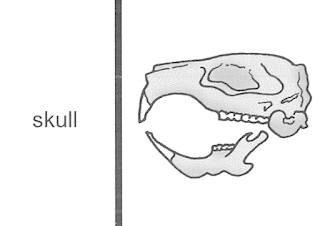Each pair was given an owl pellet. We measured the length, width, and mass of the pellet which was 7.78 g, length was 5.1cm, and width was 3.5cm. We separated the bones and fur within the pellet using a probe and foreceps. The purpose of the lab is to dissect the owl pellet and identify the prey that the certain bones belong to. We measured the length and width of the skull: 44mm and 18mm and also the length and width of the lower jaw: 27mm and 14mm.
Evidence: Our organism is a vole because of the bones we found that matched the bones of a mole. For example, the skull in our pellet exactly matches the skull of the vole shown below. The top of the cheek teeth are pointed and the tooth has individual roots on the bottom and has sharp corners.
Vole Skull:
Prey Skull:
The scapula (shoulder blade) of the prey exactly matches the bones of the vole, which supports our claim that the organism was a vole. On the sides of the scapula, both pictures have one area that is really pointed, which makes it unique from the other organisms. This narrows our choices down to just being a vole.
Vole Scapula:
Prey Scapula:
Lastly, the humerus exactly matches that of the vole as shown in this picture below. The Humerus has an irregular curve or hump on one side of the bone, which is unique to the vole. When we dissected this bone from the pellet, we found out that it matches with the humerus of the vole, therefore supporting our theory that the organism was a vole.
Vole Humerus:
Prey Humerus:
From this information, we can conclude that the organism was a vole because the bones that we found are the same as the bones of a vole. We looked at the bones of the other organisms and found nothing that matches, so we concluded that the only possible organism could be a vole.
Tibia and Fibula of Vole:
Tibia and Fibula of Human Skeleton:
Also, for differences, the skull in the human skeleton are different than that of the vole. For instance, the vole has sharper and longer teeth. The vole has sharp edges on the side of the face as shown below while humans have all pointed teeth.
The shoulder blade of the human skeleton and vole look somewhat different. The shoulder blade of the vole looks like it has a larger width than height (looks like bird wings) while the shoulder blade in humans is longer than wide. Below is a picture of the human shoulder blade and below that is the vole shoulder blade.
For similarities, both the vole and human skeletons have similar bones in the arm. For example, the lower arm of both the vole and the human consists of both the ulna and radius that have similar functions. Also, both the vole and the human skeleton consists of two bones in the lower leg. Lastly, both the vole and the human skeleton have similar femurs, which are the longest bones in the body.
Picture of Bones we found:














No comments:
Post a Comment